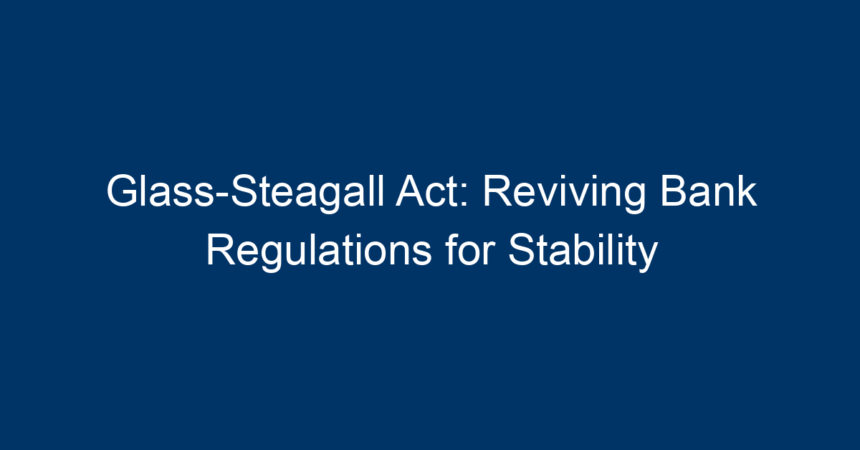In the wake of the 2008 financial crisis, the discussion surrounding banking regulations has become more pertinent than ever. One historical piece of legislation that continues to resonate in today’s financial landscape is the Glass-Steagall Act. Originally enacted in 1933, this act was designed to separate commercial banking from investment banking, aiming to protect consumers and maintain a stable economy. As the financial world grapples with increasing volatility, reviving the Glass-Steagall Act could be a crucial step toward restoring trust in the banking system. This article delves into the details of the Glass-Steagall Act, its historical context, current relevance, and practical steps we can take to advocate for stronger banking regulations.
Understanding the Glass-Steagall Act
Historical Context
The Glass-Steagall Act emerged during the Great Depression, primarily to address the rampant speculation that had led to significant economic turmoil. At its core, the act aimed to prevent banks from engaging in riskier investment activities that could jeopardize consumer deposits. By creating a wall between commercial and investment banking, the legislation sought to stabilize the financial system and protect ordinary Americans’ savings.
Key Provisions
The original Glass-Steagall Act contained several crucial provisions:
-
Separation of Banking Functions: The act prohibited commercial banks from underwriting securities or engaging in investment banking activities. This was intended to prevent conflicts of interest and ensure that banks focused on their foundational role of safeguarding deposits.
-
Creation of the FDIC: The act established the Federal Deposit Insurance Corporation (FDIC), which provided insurance for deposits up to a certain limit, promoting consumer confidence in the banking system.
- Limitations on Affiliations: It restricted affiliations between commercial banks and securities firms, ensuring that delinquent financial practices in one sector did not spill over into consumer banking.
Repeal and its Consequences
In 1999, parts of the Glass-Steagall Act were repealed by the Gramm-Leach-Bliley Act, effectively dismantling the barriers between commercial and investment banking. This deregulation contributed to a culture of risk-taking that many argue played a significant role in the lead-up to the 2008 financial crisis. Without the protective measures established by the Glass-Steagall Act, banks became more intertwined with speculative markets, leading to systemic risks that ultimately required a taxpayer-funded bailout.
The Need for Reviving the Glass-Steagall Act
Financial Instability Today
The financial landscape today is fraught with instability. With increasing income inequality, the rise of fintech, and the threat of economic downturns, many experts argue that we are witnessing a return to the predatory practices that the Glass-Steagall Act aimed to eliminate. The ever-growing size of "too-big-to-fail" banks means we need a regulatory framework that keeps financial institutions accountable.
Lessons from History
Studies have shown that the separation of banking functions under the Glass-Steagall Act led to greater financial stability. By preventing conflicts of interest, consumers were better protected, and banks had less incentive to engage in risky behavior. Reviving the Glass-Steagall Act could help reinstate these fundamental principles of financial responsibility and consumer protection.
Public Support for Regulation
Recent surveys indicate that a significant portion of the American public supports stronger banking regulations. The ongoing issues with income inequality and a perceived lack of accountability among financial institutions have led many to call for a return to the protections afforded by the Glass-Steagall Act. Bringing this issue to the forefront of political discourse could galvanize public support for renewed regulations.
How to Advocate for the Revival of the Glass-Steagall Act
Increase Public Awareness
The first step toward reviving the Glass-Steagall Act involves increasing public awareness. Understanding the nuances of banking regulations is crucial for citizens to engage meaningfully in discussions about financial stability. Educational campaigns, community forums, and social media outreach can make a difference in informing the public and building support.
Engage with Legislators
Advocating for the Glass-Steagall Act can also involve directly engaging with lawmakers. Creating petitions, attending town hall meetings, and building coalitions with like-minded organizations can increase pressure on elected officials to revisit this critical piece of legislation. Grassroots campaigns can influence legislative agendas by demonstrating public demand for regulatory reform.
Collaborate with Economic Experts
Teaming up with economists, financial analysts, and policy experts can provide valuable insights into the benefits of reviving the Glass-Steagall Act. Hosting discussions or panels can also help demystify complex concepts and emphasize the historical importance of the act in ensuring financial stability.
Support Political Candidates
When looking to support candidates who advocate for reviving the Glass-Steagall Act, it’s important to research their positions on banking regulations. Donating time or resources to campaigns that align with these values can amplify efforts to bring regulatory scrutiny back to the forefront of financial policy.
Conclusion: A Call to Action
The Glass-Steagall Act represents more than just a regulatory framework; it symbolizes a commitment to protecting consumers and ensuring financial stability. In an age where economic volatility and inequality persist, reviving this pivotal legislation could be a foundational step toward creating a more resilient banking system.
To bring the ideals of the Glass-Steagall Act back into practice, it is imperative for citizens to engage, educate, and advocate for change. The time to act is now. By raising awareness, mobilizing support, and calling for responsible banking practices, we can create a pathway for a stronger, more stable financial future.
Let’s join hands, ignite discussions, and push for the revival of the Glass-Steagall Act—for our economy, our families, and our future!




